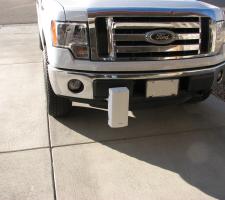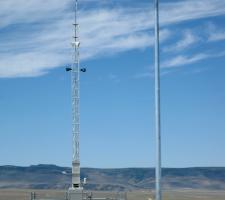
David Crawford reviews national and regional initiatives to boost Canada’s weather forecasting.
Over the next five years Canada’s national weather services are due to benefit from a CAN$248 million injection of funding into the Environment Canada (EC) department to deliver timelier and more accurate weather warnings and forecasts for users including travellers and transport operators. The scheme, set out in the country’s 2013 Economic Action Plan, is to revitalise the services with new investments in federal infrastructure such as radar networks and surface weather and climate monitoring stations.The country’s weather information resources include the Canadian Hurricane Centre, which is predicting an active hurricane season for June-November 2013. This follows on from the US National Oceanic and Atmospheric Administration’s outlook forecasting levels of activity well above seasonal averages and Environment Canada’s High-Elevation Travelers Bulletin and Special Weather Statements (when severe winter conditions are expected). This information is available to travellers planning journeys through the mountain passes of British Columbia on its weather office website - http://weather.gc.ca/forecast/public_bulletins_e.html?Bulletin=fpcn68.cwvr
With many exposed roads Canadian drivers can experience difficult conditions through a prolonged period. For instance in the winter of 2012-2013, the Hope-Kamloops section of the Trans-Canada Highway experienced 80 days with snowfalls greater than 5cm in depth. The service to monitor the 2013 – 2014 winter starts on 1 October.
The country’s provinces and industry suppliers are waiting to see what, if any, of the new funding might be available for the benefit of the road transport sector in, for instance, supporting the development of road weather information system (RWIS) stations. These road weather data stations are owned and operated by provincial governments and highway agencies and not central government. According to Jon Tarleton, roads marketing manager with the North American subsidiary of environmental management specialist
“In addition, since RWIS are typically based in rural locations, where limited data exists to begin with, providing ground truth to meteorologists has a very positive effect on [the accuracy of] weather forecasts.”
The company has, through its partnerships, active road weather programmes in place in most Canadian provinces, one of the largest being in Ontario. In Quebec, Vaisala worked on the development of a customised mobile RWIS station.
In the same line of thinking, it has recently launched a mobile, as opposed to fixed-base, condition detection product called Condition Patrol. This uses an array of on-vehicle sensors to monitor eg air and road temperatures, road surface state, friction/grip characteristics, thickness of water or ice and atmospheric moisture.
The resulting data can be viewed on a dashboard-mounted smartphone app or relayed back to a control centre for highway operatives to view in Vaisala’s road weather management software. With many of Canada’s highway operations being privatised, Tarleton sees the product being used by agencies as a live evaluation tool for monitoring maintenance and weather-response contractors’ performance.
Weather issues for the province of Alberta include the vulnerability – especially in winter – of the 260km-long Queen Elizabeth II Highway. This highway carries 30,000 to 50,000 vehicles a day between Calgary and Edmonton and is at risk of recurring environmental disasters such as flooding - the worst case of which occurred in the summer of 2013.
In response,
Alberta Transportation has chosen French-based control and data handling specialist Schneider Electric to deliver the stations (each of which is equipped with multiple road pavement and six atmospheric sensors) and 15 video traffic management systems (VTMS). These are sited at critical traffic locations such as bridges and interchanges, on both the national and provincial highway networks and are supported by the company’s Maintenance Decision Support System.
The resulting data and camera images are relayed to Schneider’s MxVision WeatherSentry online interface, for processing and checking and to be available to Alberta Transportation’s regional staff and highway maintenance contractors. At the same time, Schneider’s forecasting division generates hourly atmospheric and road pavement forecasts for the next 36 hours along with aggregated local area forecasts.
The implementation is building on existing smart grid and smart city infrastructures in Alberta and Calgary, its largest city, to deliver more effective integration with Alberta Transportation’s ITS deployment programmes. Alberta Transportation is looking to increase the detail (or granularity) in both weather and road surface condition forecasts to keep it better informed, on an hourly basis, about the wider extent of its highway network.
This will make its highway maintenance department more efficient in deploying resources for road treatment. At the same time, traffic managers will enjoy clearer visualisation of road conditions and incident status for the more effective deployment of emergency services.
The RWIS deployment programme incorporates an agreement between Alberta Transportation and Environment Canada to give the latter access to the raw data. This requires adherence to Environment Canada’s standards for station location, equipment specifications and data requirements.
In February 2013 Alberta Transportation launched a new 511 Alberta traveller information service aimed at improving trip planning and road safety – notably during winter months. It uses the US-originated universal three-digit telephone number for location-independent travel advice – with touch tone or voice command options – alongside a www.511.alberta.ca website.
This gives access to over 100 highway cameras and links with interactive maps for current information on highway and weather conditions. The new 511 Alberta replaces a previous Alberta Motor Association service using data provided by the Alberta Government and will be developed to provide a wider range of features in response to user feedback.
Adding traffic management capability
Vaisala is currently working with various Canadian provincial and city government agencies on methods for bringing road weather data into formats that could be useable by departments concerned with traffic management, infrastructure planning and ITS deployment. This, says Tarleton, is “a new concept, when compared to maintenance departments being the sole users of RWIS data.
“We do see urban traffic management benefiting from the availability of such data, and Vaisala intends to be involved. We have maintained for many years a traffic weather consulting division, set up to help our customers with such decision-support programmes”.
The initiative parallels activity in the UK where Vaisala and public infrastructure management company
The group aims to help fill what it sees as a gap for translating weather and road condition data into information that can help urban traffic managers make more intelligent assessments of how they expect road users to drive in adverse weather conditions. This information will be used to determine the resulting impacts on traffic flows at interfaces between highways and urban roads and on signal timings















